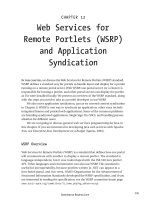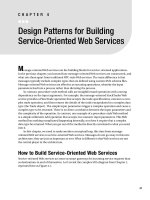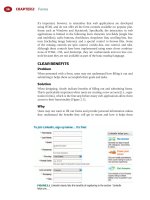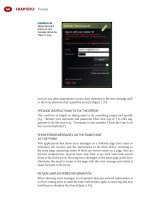Design Patterns for Building Message-Oriented Web Services
Bạn đang xem bản rút gọn của tài liệu. Xem và tải ngay bản đầy đủ của tài liệu tại đây (542.86 KB, 26 trang )
Design Patterns for Building
Message-Oriented
Web Services
I
n an SOA, the purpose of Web services is to exchange and process XML messages, not simply
to act as hosts for remote procedure call (RPC) style methods. The difference is that messages
are bound to rich and complex operations, whereas RPC-style methods simply return a dis-
crete result that is directly correlated to a specific set of input parameters. For example, a
message-oriented Web method will accept a stock ticker symbol and return a detailed stock
quote in response. In contrast, an RPC-style Web method will return a simple output value.
Unfortunately, development tools such as Visual Studio place a method-centric focus on
Web services that causes you to lose sight of the bigger design picture and to take the under-
lying infrastructure for granted. It is very easy to build a Web service by creating an .asmx file
and then throwing together several loosely related RPC-style Web method implementations.
However, this is the wrong design approach because such a Web service fails to provide an
integrated set of message endpoints. In simpler terms, the Web service fails to provide a serv-
ice. The right design approach is always to think in terms of operations and XML messages
and to consider how the Web service methods work together to provide a service.
This chapter begins with a challenge for you to set aside what you have learned about
Web services development until now and to open your mind to a different design approach—
one that is based on integrated XML messages, not on RPC-style methods.
How to Build a Message-Oriented Web Service
There are six steps involved in building a message-oriented Web service, which is simply a
Web service that exchanges XML schema–based input and output messages rather than
simple parameter-oriented values. The steps are described in the following sections.
Step 1: Design the Messages and the Data Types
Conceptually design what the messages and data types will look like. UML class diagrams are
the best way to capture this information, and there is the added benefit that many of today’s
UML tools support XML schema generation directly from UML class diagrams.
31
CHAPTER 3
701xCH03.qxd 7/17/06 12:54 PM Page 31
Step 2: Build the XSD Schema File for the Data Types
Use an XML designer tool to build the XSD schema file for all of the data types that are
exchanged by the Web service methods. Visual Studio 2005’s XML Designer is a good tool,
but you can use any XML designer tool that you are comfortable working with.
Step 3: Create a Class File of Interface Definitions for the
Messages and Data Types
The interface definition class (IDC) file provides the abstract definitions of the Web service
methods and its data types. This class file derives from the System.Web.Services.WebService
class, so it can be readily implemented in a Web services code-behind file. The .NET Frame-
work provides a command-line tool called xsd.exe for generating an IDC file based on an XSD
schema file. This will manually generate class definitions for the data types. You can add this
class file to your Web service project and then manually insert abstract definitions for the Web
methods.
Optional Step 3A: Generate the WSDL Document Manually
If you are brave enough, you can generate the WSDL document manually once you have built
the XSD schema file. However, the only real benefit you gain from this step is that you are then
able to fully generate the IDC file using the wsdl.exe command-line tool. It is easier to follow
step 3 (explained previously), using xsd.exe combined with manual coding of the abstract
method definitions. The syntax of WSDL documents is very difficult to build correctly by hand.
(Chapter 2 of this book, which reviews the structure of WSDL documents, is essential reading,
so that you can understand how the WSDL document is structured and how it relays Web serv-
ice metadata to Web service clients.)
Step 4: Implement the Interface in the Web Service
Code-Behind File
Your hard work in steps 1 through 3 pays off, and you are now ready to implement code
for the Web methods. The Web service .asmx code-behind class derives from the
System.Web.Services.WebService class by default, as does the IDC file from step 3, so you
can derive the .asmx code-behind class directly from the interface definition class instead of
directly from System.Web.Services.WebService. You can then implement code for each of the
methods.
Step 5: Generate a Proxy Class File for Clients Based on the
WSDL Document
Web services have no reason to exist unless they are being used by clients. In this step, you
generate a proxy class file based on the Web service WSDL document so that clients know
how to call your Web service, and know what messages and data types will be exchanged. The
wsdl.exe command-line tool will automatically generate this proxy class for you based on the
WSDL document. And Visual Studio 2005 will automatically generate the WSDL document for
you, so no manual work is required.
CHAPTER 3
■
DESIGN PATTERNS FOR BUILDING MESSAGE-ORIENTED WEB SERVICES32
701xCH03.qxd 7/17/06 12:54 PM Page 32
You can actually skip this step if you are developing with Visual Studio 2005, because it
will dynamically generate the proxy class file for you when you add a Web reference (for your
Web service) to a client project. However, we prefer to manually generate the proxy class file so
that we can either alter it or have it ready for clients who are using a development tool without
code-generating wizards.
Step 6: Implement a Web Service Client Using a Proxy Class File
This final step hooks a client to your Web service. If you are using Visual Studio 2005, simply
add a (dynamic) Web reference to the Web service in your client project, and this will auto-
matically generate the proxy class file for you. This wizard will also make the necessary
adjustments to your application configuration file to record the location of the Web service.
Alternatively, you can manually add the proxy class file from step 5 to your project, update the
configuration file, and begin coding. The client essentially does nothing more than delegate
method calls to the Web service. Valid clients include Web applications, Windows Forms appli-
cations, console applications, or even other Web services.
Next Steps
This process is obviously more involved than simply creating a new .asmx file and immedi-
ately implementing code. But it is the right way to do things because it abstracts out the Web
service definitions and the code implementations. Visual Studio and the .NET Framework pro-
vide all of the tools that you need to autogenerate the XML-based files and the code, so the
amount of manual work is kept to a minimum.
The rest of this chapter dissects the various moving parts that make up a message-
oriented Web service. You will gain a precise understanding of how multiple files and tools
work together to define and implement a message-oriented Web service. We will also provide
selective implementation examples that collectively show you how to build this type of Web
service from scratch.
WHAT ARE DESIGN PATTERNS?
Design patterns are loosely described as time-tested, established solutions to recurring design problems.
Formal design patterns are highly structured and follow strict templates. The design patterns that are pre-
sented in this book do not follow this rigorous format, but they are in keeping with the spirit of design
patterns because they factor in industry-accepted practices for approaching recurring design problems.
CHAPTER 3
■
DESIGN PATTERNS FOR BUILDING MESSAGE-ORIENTED WEB SERVICES 33
701xCH03.qxd 7/17/06 12:54 PM Page 33
Design and Build a Message-Oriented Web Service
This section provides the information that you need in order to build a message-oriented Web
service. It is organized along the same six steps presented earlier and provides both concep-
tual information and implementation information.
The Role of XML Messages and XSD Schemas
The starting point in designing a Web service is to determine what XML messages it will
exchange—specifically, what messages it will respond to, and what messages it will return.
Figure 3-1 shows the standard architecture for a client that interacts with a Web service via a
proxy class. This architecture is based on the principle that the client and the Web service both
have a common understanding of the messages and data types that are exchanged between
them. This understanding can only be achieved if the Web service publishes a clear document
of the operations that it supports, the messages it exchanges, and the types that it uses. This
document is the WSDL document (described in Chapter 2). The WSDL document is the main
reference for describing a Web service, and it includes embedded type definitions and mes-
sage definitions, among other things.
Figure 3-1. Web services architecture showing communication between the client and service
Consider the example Web service, StockTrader, from Chapter 2 that provides methods for
retrieving stock quotes and placing trades. Listing 3-1 presents one of the Web methods called
RequestQuote that accepts a stock ticker symbol and returns a detailed stock quote.
CHAPTER 3
■
DESIGN PATTERNS FOR BUILDING MESSAGE-ORIENTED WEB SERVICES34
701xCH03.qxd 7/17/06 12:54 PM Page 34
Listing 3-1. Pseudocode for the RequestQuote Web Method
[WebMethod]
public Quote RequestQuote(string Symbol)
{
// implementation code
}
public class Quote
{
public string Symbol;
public string Company;
public string DateTime;
public System.Double High;
public System.Double Low;
public System.Double Open;
public System.Double Last;
public System.Double Change;
public System.Double PercentChange;
public System.Double Previous_Close;
public string High_52_Week;
public string Low_52_Week;
}
This code listing represents a Quote type object and a method called RequestQuote that
returns a Quote object. The RequestQuote method actually represents two messages: an input
(or request) message that includes a stock ticker symbol; and an output (or response) message
that provides a detailed stock quote. A client can only use the RequestQuote method if it can
also understand the response. In other words, the client has to fully understand the definition
of the Quote type in order to make use of the RequestQuote method. This is exactly the kind of
information that WSDL documents and XSD schema files document.
Listing 3-2 shows what the RequestQuote input and output messages look like in WSDL.
Listing 3-2. WSDL for the RequestQuote Input and Output Messages, Including Associated Types
<wsdl:message name="RequestQuoteSoapIn">
<wsdl:part name="parameters" element="tns:RequestQuote" />
</wsdl:message>
<wsdl:message name="RequestQuoteSoapOut">
<wsdl:part name="parameters" element="tns:RequestQuoteResponse" />
</wsdl:message>
<wsdl:portType name="StockTraderSoap">
<wsdl:operation name="RequestQuote">
<wsdl:input message="tns:RequestQuoteSoapIn" />
<wsdl:output message="tns:RequestQuoteSoapOut" />
</wsdl:operation>
</wsdl:portType>
CHAPTER 3
■
DESIGN PATTERNS FOR BUILDING MESSAGE-ORIENTED WEB SERVICES 35
701xCH03.qxd 7/17/06 12:54 PM Page 35
<wsdl:types>
<s:schema elementFormDefault="qualified"
targetNamespace=" /><s:import namespace=" />
<s:element name="RequestQuote">
<s:complexType>
<s:sequence>
<s:element minOccurs="0" maxOccurs="1"
name="Symbol" type="s:string" />
</s:sequence>
</s:complexType>
</s:element>
<s:element name="RequestQuoteResponse">
<s:complexType>
<s:sequence>
<s:element minOccurs="0" maxOccurs="1"
name="Quote" type="s1:Quote" />
</s:sequence>
</s:complexType>
</s:element>
</s:schema>
</wsdl:types>
Listing 3-3 shows what the Quote type and Symbol type look like in an XSD schema file.
Listing 3-3. XSD Schema for the Quote and Symbol Types
<?xml version="1.0" encoding="utf-8" ?>
<xs:schema id="StockTrader"
targetNamespace=" />elementFormDefault="qualified"
xmlns=" />xmlns:mstns=" />xmlns:xs=" version="1.0">
<xs:complexType name="Quote">
<xs:sequence>
<xs:element name="Symbol" type="xs:string" />
<xs:element name="Company" type="xs:string" />
<xs:element name="DateTime" type="xs:string" />
<xs:element name="High" type="xs:double" />
<xs:element name="Low" type="xs:double" />
<xs:element name="Open" type="xs:double" />
<xs:element name="Last" type="xs:double" />
<xs:element name="Change" type="xs:double" />
<xs:element name="PercentChange" type="xs:double" />
<xs:element name="High_52_Week" type="xs:double" />
<xs:element name="Low_52_Week" type="xs:double" />
</xs:sequence>
CHAPTER 3
■
DESIGN PATTERNS FOR BUILDING MESSAGE-ORIENTED WEB SERVICES36
701xCH03.qxd 7/17/06 12:54 PM Page 36
</xs:complexType>
<xs:element name="Symbol" type="xs:string"></xs:element>
</xs:schema>
This schema representation of the Quote type is significant because it qualifies the type
definition based on a specific target namespace, in this case estonepartners.
com/schemas/StockTrader/. Although there may be many variations of the Quote type in the
world, this specific qualified definition is unique. The Symbol type is nothing more than a
standard string type element, but it is qualified to a specific namespace and therefore
becomes more than just a standard element. Schema files are essential to ensure that a
Web service and its clients are absolutely clear on the messages and type definitions that
are being exchanged between them. Schema files are how you define messages.
■
Note
XSD schema files should always define types using nested elements rather than attributes. This
makes the file easier to read and reduces the possibility of errors during processing.
The Quote and Symbol types look very similar if they are embedded directly in the WSDL
document within the <types> section; and you should always assign qualified namespace
information to embedded types. In addition, you should always abstract type definitions out
to a separate XSD schema file for reference purposes, even though it is redundant to the
embedded type information contained within the WSDL document. Separate XSD schema
files are useful for a lot of reasons. Most importantly, they allow different Web services to use
the same qualified types and to reference them based on a single XSD schema file in a single
physical location. Life would get very confusing if you had multiple embedded definitions of
the same qualified data type floating around in cyberspace. In addition, dedicated XSD
schema files help you validate XML messages. In .NET you can load an XSD file into an Xml-
ValidatingReader object and use it to validate XML messages. You can also use schema files
with the xsd.exe command-line utility to generate class file definitions for types.
■
Note
The target namespace is typically expressed as a Uniform Resource Identifier (URI), but it is not
required to resolve to an actual location. The schema definitions that are presented in this book happen to be
stored as XSD files at
/>. For your convenience, they are
also included in the sample code downloads (available in the Source Code/Download section on the Apress
web site at
).
Design the XML Messages and XSD Schemas (Step 1)
XML messages represent the operations that your Web service supports, and they correlate to
implemented Web methods. XML messages do not contain implementation logic. Instead,
they simply document the name of an operation and its input and output types. XML mes-
sages must be designed in conjunction with XSD schema files. The best starting point is to
CHAPTER 3
■
DESIGN PATTERNS FOR BUILDING MESSAGE-ORIENTED WEB SERVICES 37
701xCH03.qxd 7/17/06 12:54 PM Page 37
construct a UML diagram for the operation. Figure 3-2 shows a UML class diagram for the
RequestQuote operation and its associated input and output data types.
Figure 3-2. UML class diagram for the RequestQuote operation
The UML class diagrams will map conceptually to XSD schemas, so you do not have to
sketch out any XML during the design phase unless it helps you to better visualize the XML
messages and types. For example, here is what the Quote type will look like within a SOAP
response (with the embedded namespaces omitted for clarity):
<Quote>
<Symbol>MSFT</Symbol>
<Company>Microsoft Corporation</Company>
<DateTime>11/17/2003 16:00:00</DateTime>
<High>26.12</High>
<Low>24.68</Low>
<Open>25.49</Open>
<Last>25.15</Last>
<Change>-0.36</Change>
<PercentChange>-0.0137</PercentChange>
<Previous_Close>25.49</Previous_Close>
<High_52_Week>35</High_52_Week>
<Low_52_Week>22</Low_52_Week>
</Quote>
For design purposes, you can simplify the XML down to this:
<Quote>
<Symbol />
<Company />
<DateTime />
<High />
<Low />
<Open />
<Last />
CHAPTER 3
■
DESIGN PATTERNS FOR BUILDING MESSAGE-ORIENTED WEB SERVICES38
701xCH03.qxd 7/17/06 12:54 PM Page 38
<Change />
<PercentChange />
<Previous_Close />
<High_52_Week />
<Low_52_Week />
</Quote>
Clearly, it is a lot of work to sketch out even this simplified XML by hand, and it does not
provide any additional value beyond what the UML diagram provides. In fact, it provides less
because this sketched out XML provides no type information. So the message here is that for
efficiency you should design your XML messages using UML or any appropriate shorthand
notation. This is the extent of the design work that is minimally required, and you should
never shortcut this step.
Build the XSD Schema File (Step 2)
Once you have established what your XML messages and data types will look like, it is time to
start building them. XSD schema files are the building blocks for XML messages, so you need
to design the schema files first. XSD schema files may be coded by hand, but it is easier to use
a visual designer tool, such as Visual Studio 2005’s XML Designer. To access the designer, sim-
ply add a new XSD schema file to a project. Visual Studio provides both a visual design view
and an XML design view. Figure 3-3 illustrates the visual design view for StockTrader.xsd,
which defines all of the data types for this chapter’s StockTrader sample application.
Figure 3-3. The Visual Studio 2005 XML Designer, showing the StockTrader.xsd schema
CHAPTER 3
■
DESIGN PATTERNS FOR BUILDING MESSAGE-ORIENTED WEB SERVICES 39
701xCH03.qxd 7/17/06 12:54 PM Page 39
The XML Designer includes toolbox elements that you can drag onto the surface of the
designer and then fill in, as shown in Figure 3-4. For example, it provides a toolbox element for
XML complex types. Simply drag this element onto the designer and provide a name for the
complex type. Then start specifying the included types by their name and type. Once you are
finished defining all of the types, switch to the XML view to view the resulting XML. You can
then copy and paste the XML into a Notepad file and save it with an .xsd extension.
Figure 3-4. The Visual Studio 2005 XML Designer toolbox
You do not need to build the XML message documents by hand because they are created
as part of the WSDL document, which Visual Studio 2005 will automatically generate. But you
will need to code the abstract method definitions in an IDC file so that the WSDL generator
knows what XML messages to create. The IDC file contains type definitions and abstract
method definitions.
The Role of the Interface Definition Class File
The IDC file contains two important sets of information:
• Class definitions for all custom types that are exchanged by the Web service
• Abstract class definitions for each operation that the Web service supports
Listing 3-4 provides the code for an IDC file for the RequestQuote operation and its asso-
ciated types.
CHAPTER 3
■
DESIGN PATTERNS FOR BUILDING MESSAGE-ORIENTED WEB SERVICES40
701xCH03.qxd 7/17/06 12:54 PM Page 40









